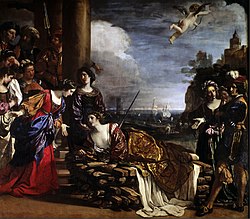The Legend of Good Women
The Legend of Good Women is a poem in the form of a dream vision by Geoffrey Chaucer during the fourteenth century.
The prologue describes how Chaucer is reprimanded by the god of love and his queen, Alceste, for his works—such as Troilus and Criseyde—depicting women in a poor light.
Criseyde is made to seem inconstant in love in that earlier work, and Alceste demands a poem of Chaucer extolling the virtues of women and their good deeds.
For thy trespas, and understond hit here: Thou shalt, whyl that thou livest, yeer by yere, The moste party of thy tyme spende In making of a glorious Legende Of Gode Wommen, maidenes and wyves, That weren trewe in lovinge al hir lyves; And telle of false men that hem bitrayen, That al hir lyf ne doon nat but assayen The incomplete nature of the poem is suggested by Chaucer's Retraction from The Canterbury Tales which calls the work the xxv.
The command of queen Alceste is said, by John Lydgate in The Fall of Princes, to be a poetic account of an actual request for a poem by Anne of Bohemia who came to England in 1382 to marry Richard II.
The supposed royal command is one suggested reason for the poem's unfinished state as Chaucer got bored with the task and gave up.
Several passages hint at Chaucer's dissatisfaction: But for I am agroted [stuffed] heer-biforn To wryte of hem that been in love forsworn, And eek to haste me in my legende, Which to performe god me grace sende, Therfor I passe shortly in this wyse; These lines, late in the poem, could simply be occupatio or paralipsis, the rhetorical device common in Chaucer of bringing up a subject merely to say you will not mention it.
The work is rather inconsistent in tone, with tragedy mixed uncomfortably with comedy, and the legends are all somewhat similar with little of the characterisation which is key to The Canterbury Tales.
The nature of the poem with its separate legends makes dating it difficult but it is clearly placed between Troilus and the Tales around 1386/1388.
Chaucer seems to have returned to the work a decade later to rewrite the prologue, but the latter text, which survives in only one manuscript, is generally considered inferior to the original.
A thousand tymes have I herd men telle, That ther is Ioye in heven, and peyne in helle; And I acorde wel that hit is so; But natheles, yit wot I wel also, That ther nis noon dwelling in this contree, That either hath in heven or helle y-be, Tennyson used the poem as theme for his own poem A Dream of Fair Women.
The poet recounts ten stories of virtuous women in nine sections: Cleopatra, Thisbe, Medea, Phyllis, Hypsipyle, Ariadne, Lucretia, Philomene, Hypermnestra, Dido.
Chaucer's sources for the legends include: Virgil's Aeneid, Vincent of Beauvais, Guido delle Colonne's Historia destructionis Troiae, Gaius Julius Hyginus' Fabulae and Ovid's Metamorphoses and Heroides.
The prevailing theory is that the contemporary criticism of the story following its release motivated Chaucer to sanitize or edit his prologue to be more fitting for the audience at hand.
Chaucer’s motivation for authoring the work in the first place is understood as a penance of his previous and unflattering depictions of women in his society.
The context of the story, and the subject matters relations to the other works of Chaucer tells us that it was most likely penned sometime in the midpoint of his career.
Contemporary English criticism and analysis of these two prologues has traditionally focused on the opening paragraphs of both versions, since the first half of both poems are largely identical.
[1] In the prologue itself, Chaucer states how its authorship was motivated by his previously ill portrayal of women in his other works.
Was Chaucer simply trying to sanitize his public image or was he really admentally motivated in creating a companion text for women to utilize?
Alternatively, other scholars have attempted to scatologically categorize these arguments and debates into definitive references of the ongoing conversation itself.
[2] The most recent additions to the conversation more or less look like this, compendiums of the past critical analysis and prevailing hypothesis with a new theory presented at the conclusion.
The most clear depiction of the importance of women to this piece would be the ten female characters: Cleopatra, Thisbe, Dido, Hypsipyle, Medea, Lucrece, Ariadne, Philomela, Phyllis and Hypermnestra.
Nicola F. McDonald notes that throughout the narratives, Chaucer makes reference to his predominantly female audience and even questions them in the piece itself.
These pagan mythological characters whose stories all include love and betrayal could serve as warnings and cautionary tales to the poem’s female readers.
[5] McDonald also speculates that some of the text might serve as “motherly advice” to young women on how they should act and think properly during that time period which would also support the idea that this poem was meant for a female audience.
Although this series of poems seems to be about the legends of these women and their difficulties with love, it has a political undertone that points to the controversial topic of individualism.
Helen Phillips writes that Chaucer uses a specifically “amorous” tone in these poems to veil this controversy, while adding in political jargon to these otherwise unpolitical stories to still suggest this underlying topic.
